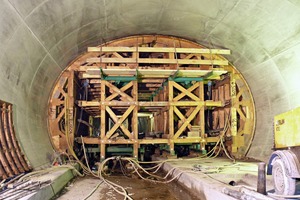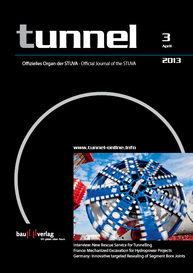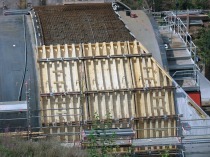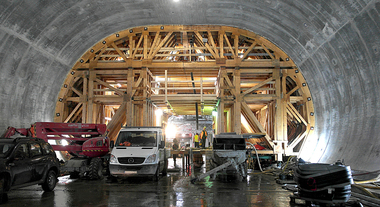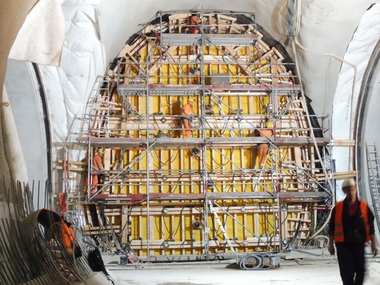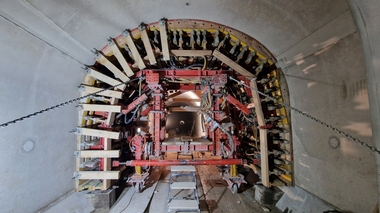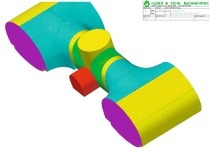Bleßberg Tunnel; Shuttering Panels made of solid Plastic secures better Result with lower Costs
Admittedly replacing shuttering panels takes time and money and in tunnelling this procedure is always especially complicated and expensive. Thanks to the robust alkus solid plastic panel, the Huber & Sohn, Eiselfing/D company saved these costs during the Bleßberg tunnelling project – while producing better surfaces at the same time.
The Bleßberg Tunnel – 8,314 m – is the longest rail tunnel on the new Ebensfeld-Erfurt-Leipzig/Halle route and part of the VDE 8 (VDE = German Unification Traffic Project) rail project Nuremberg-Berlin. It is intended to ensure that from 2017 travelling time between Munich and Berlin will be reduced to roughly 4 hours. With maximum overburden of 330 m the tunnel penetrates the heights of the Thuringian Forest between Truckenthal and Goldisthal. A part of the renowned Rennsteig rambling trail is located above the tunnel. The Bleßberg North JV comprising the companies Ed. Züblin AG, Stuttgart and Bickhardt Bau AG, Kirchheim/D is producing the roughly 4,000 m long twin-track northern part-section and the necessary secondary structures. As sub-contractor, Huber & Sohn, Bachmehring/D, was commissioned to produce 9 enlargement niches and 3 turning points with turning area and a link to the main tunnel in the parallel running evacuation tunnel.
Mobile Vault Formwork Carriages with alkus Face Formwork
The shuttering elements are prefinished at the factory by carpenters. This has the advantage that the elements are absolutely custom-built. The GM 6 face formwork, which is 6 mm thick, is used for curved surfaces. Huber & Sohn has already used this form lining with great success in the past. The fibre-glass reinforced panel is pliable and fits the corresponding radius unproblematically – enabling prompt and straightforward assembly. Compared to timber it caters for considerably better surfaces and saves especially complicated and expensive replacing of shuttering panels.
For similar projects the company first of all produced the walls and then the parapets on account of the more straightforward logistics. However for 6 of the 9 enlargement niches the complete vault had to be shuttered and concreted in a single working cycle to adhere to schedule. For this reason, Huber & Sohn devised a 19 m long, mobile vault formwork carriage. The stable steel-wood-structure can be divided in order to be transported.
Alkus Face Formwork substantially more economic
The enlargement niches are each roughly 20 m long. The formwork carriage was assembled on-site without difficulty. After concreting and attaining the necessary strength, the walls were retracted and the parapets folded. Then the formwork carriage, which could be divided at its centre, was relocated for the second cycle. After concreting, stripping was again carried out and the 2 parts relocated for the next enlargement niche. By means of this procedure, the 6 enlargement niches and a further 6 sections in the 3 turning points were completed according to schedule. The formwork panels were practically devoid of wear phenomena following these 20 applications.
According to Ernst Flößer, the department head for formwork construction, and the project manager on the construction site, the concreted surfaces are comparable with those in the evacuation tunnel, which were produced using steel formwork panelling. In this respect, the alternative with alkus face shuttering was considerably more economic for the contractor’s tasks. Even plywood as a shuttering element is too expensive on account of the need to replace the formwork. The same panel was used more than 70 times for earlier construction projects.

